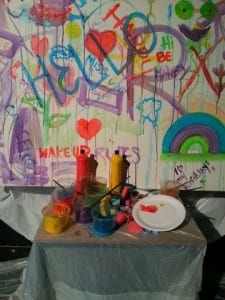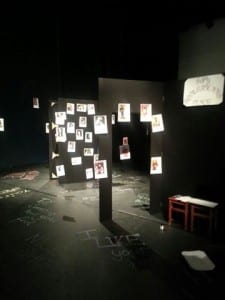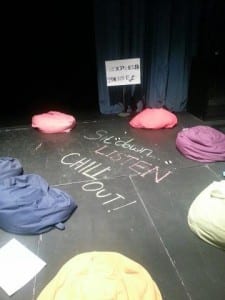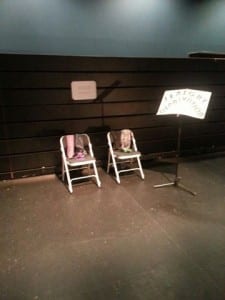On the 16th of May, we held our Installation piece from 1-5pm in the LPAC auditorium. This piece entirely focussed on the audiences mood and each section was designed to affect their moods, whether it was, expressing, releasing, forced upon or manipulation.
After much discussion and justification, we decided it would be beneficial if we did not perform in our installation piece after all. This is because if the audience members had all six of our group members in the five sections, we thought we might influence their participation. We thought back to experiment of our trip to town when we asked people to ‘say something nice’ and they couldn’t think of anything on the spot, or felt embarrassed in front of us. Therefore, we thought we would let the audience members do all the participating their selves without any influence and pressure from us.
Throughout the installation, we ensured that at least one member of our group was in the performance at all times. This was to not only to make sure everything was running okay, e.g. enough crockery and balloons were set out, sensory derive audience members with blind folds and headphones, but to also experience for ourselves how the audience members reacted to our sections within our piece. Seeing each audience member experience totally different things and genuinely see their mood change was a very important aspect of our piece.
Firstly, we set up all of our five locations in the auditorium and made sure everything was in order. We then set up all of our technical elements and ran some aspects that need to happen in our performance, including blackouts, and the projection starting from the beginning at the same time. We also tested the plate smashing location for the health and safety of our audience members.
The first section was the paint section called ‘Colour Explosion’, this is where two canvases were set out for the audience to pop balloon or either paint on the blank canvas, for us to see how this would affect their mood. This idea was influenced by Franko B’s performance I miss you and Yves Klein Blue. Both of these performances used their bodies and expressed their bodies through paint in order to see how this would affect people in different ways. We originally were going to paint our bodies within this part of the exhibition but wanted the audience to express themselves without any direction.
The balloon and painting canvas was a huge success and audience members kept going back to pop or paint more throughout their visit. The twitter feed expressed some very interesting things about their painting and balloon popping experience. One audience member said ‘they could paint on here all day’ as it made them feel better. As I was relaxing in the Express Yourself section, I heard people laughing and saying how much they loved popping the balloons. This was very reassuring to see their mood change in front of my eyes.
This section was called Say Something Nice, which was obviously influenced by Improv Everywhere’s piece of the same name. We was influenced strictly on the friendly nature and the meaning of this piece and we thought that this would definitely affect someone’s mood as they would feel better that they have said something nice. We asked the audience to walk around the space and if they wanted to say something nice about the pictures we had displayed or if they wanted to write on the floor something nice for the audience to see then they could. This exercise was to make the audience feel good about them after they have said something nice to other members of public or our group members.
This section was also influenced by Franko B as we focussed this section on body originally but instead of using our actual bodies we used pictures of our bodies instead.
This section finished off with numerous comments upon each picture, quotes written on the floor and also people drew picture of rainbows and flower on the floor. Even though this wasn’t asked of the audience, it was very nice to see that the audience members used their own imagination of how to express what mood they are in. After reading the comments people left for us on the pictures, also changed my mood, as instead of picking out the negative things about our bodies what we personally don’t like about ourselves, reading nice things about our bodies make us feel better about ourselves.
A member of the audience came up to me and they said, when they were in the ‘say something nice’ section, she was writing on all of the photo’s that she will miss us and started off doing it very happily, until the music then changed into a sad slow piece, which made her feel upset towards her seeing us leave.
This section is called Express Yourself where the audiences was invited to sit/lay down on the beanbags provided and listen to the music we played for them and relax. This was influenced by all of our group’s enthusiasm towards music and how we all use it to change our mood on a day-to-day basis. We thought that this section would allow the audience to escape from their own personal lives and find a minute to think about their selves and listen to the music and how it helps to change the way you feel, even if your sad, stressed, angry, calm, happy, tired.
This section finished off more successful than what it first started as, due to it becoming busier towards the end so more people was using it to laugh, joke and talk about the music that was being played and how it made them feel. Also people was talking about the memories they had from the songs as it goes to show you, even if the actual song tempo, lyrics don’t change your mood, the memories you had with song will make you feel emotion which will change your mood.
This section was called Sensory Deprivation. This is where the audience member was tied up and blindfolded on a chair, with music played through the headphones that were available for them. This exercise was based on how removing the senses and listening purely to the songs that was played to them affected their mood.
Within our performance I left one audience member for five minutes tied up in the chair and gave her one of my favourite songs to listen to called Chocolate by The 1985. This song makes me feel much happier as it’s an uplifting but tranquilising beat to it. As I untied the woman in the chair, she stated that she could’ve sat there for ages as she felt so relaxed. I am surprised by her response as I personally didn’t think she would like that type of music due to the age difference. It goes to show you that the music can have a same affect on someone that you lest expected it from.
The last part of our installation was called Loose It. This section was simply an X labelled on the floor where the audience members were asked if they wanted to smash a piece of crockery on the floor. This was designed for the audience members to release some anger or tension to make them feel better.
Some audience members seemed very on edge about the whole smashing plate effect and jumping with the sound of it; whereas I witnessed most audience members enjoy smashing the crockery and releasing some tension. I saw one audience member smashed five pieces of crockery straight after each other with a huge smile across her face. This part of the piece was the most interesting for me personally as you could see the audience members feeling very unsure about the whole idea before hand and then as soon as they smashed the plate you could see how satisfying it was for them. Unfortunately, this section had to be cancelled after the first hour due to technical problems, as the crockery was damaging the auditorium. We all still got to see what we wanted from this section though, so I am not completely disheartened that it didn’t go on for the whole duration.
Overall, I am very happy with how successful the installation was and I believe it ended up with a better outcome than what I first expected, due to it being 100% audience participation I was worried that we was not going to get as many audience member than what turned up. All the audience was fantastic and did entirely what we hoped for. They also all remembered to tweet their experience and how they felt. The paint canvases are now going to be displayed in the LPAC cafe for other people to see.
If we were going to further our cause and affect experiment I would love to go out to other communities and see the different outcomes we would get. This experiment was mainly only drama students, so it would be extremely interesting to see how the outcome would differ in the centre of Lincoln town or designed for specific communities e.g. religion, homeless people, hospitals etc. It would be exciting to see how their painting canvas would turn out like and what specific words and pictures they would incorporate.
Anthony Howell talks about a performance that took place in Kentish town in 1975 called The Street:
‘Everybody on the street, which was a sort of mixture of working-class and middle-class people, externalised their sitting rooms and put them out on the pavement. But it was all conceptual. It involved participation in concepts which we found that people of all walks of life immediately related to and enjoyed without feeling patronised.’ (1998, p.131)
He states that people would participate in the streets as they won’t feel patronised and they can relate to it and enjoy it, this could be maybe somewhere we could do our next piece of work, if we ever get the opportunity to do so.





